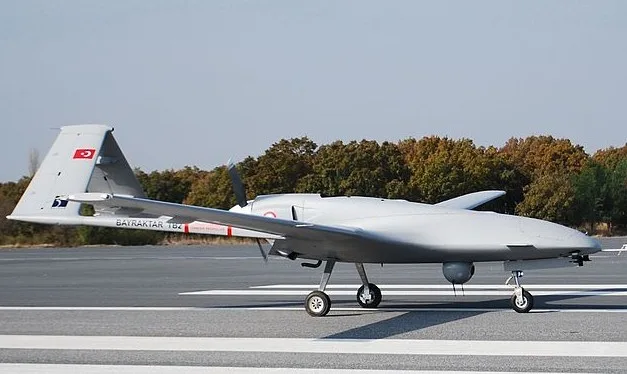Maldives has launched its first tactical drones. The eyes in the sky will improve the country’s defence force’s monitoring, surveillance, and data capabilities.
 The Turkish-supplied Bayraktar TB2 will help patrol the Indian Ocean around the Maldives. : Bahaluk CCBY4.0
The Turkish-supplied Bayraktar TB2 will help patrol the Indian Ocean around the Maldives. : Bahaluk CCBY4.0
Maldives has launched its first tactical drones. The eyes in the sky will improve the country’s defence force’s monitoring, surveillance, and data capabilities.
The recent shipment of Turkey-supplied Bayraktar TB2 armed tactical drones will introduce Maldives’ defence industry to more sophisticated military technologies.
The technology is set to help patrol the Indian Ocean around the archipelago, a task that Maldives formerly performed with the assistance of India and Sri Lanka.
Instead, it is now hoped the Maldives National Defence Force’s officers and crews of maritime vessels will have better awareness and surveillance capabilities against any threats emerging from and outside the country’s territory – the new drone platform will complement the existing regional arrangements.
The drones were introduced by President Dr Mohamed Muizzu at the inauguration of the first Air Corps of the Maldives Defence Force in March 2024.
The Turkish-made drone was brought to Maldives under a new bilateral cooperation between the countries. Some of the initial diplomatic talks gained weight in President Muizzu’s first international trip after assuming office in November 2023.
The Bayraktar TB2, sold by Turkish military contractors to 33 countries, has been used in conflicts from Azerbaijan and Libya and helped Ukraine fight back the Russian invasion in the early stages of the war.
But this is not a purely aggressive posturing for a drone system that can be effective in warfare.
Maldives requires this new technology as a developing nation fighting against geography – this primarily involves various forms of non-traditional threats arising from the broad maritime domain.
Maldives has a total land area of 20,130 square km (formed by 1190 islands) situated in 974,000 square km of the Indian Ocean that needs constant watch against internal and external threats.
More than 98 percent of its territory is open water.
This drone system can provide the platform for effective surveillance and search and rescue capabilities, and for collecting data on local and commercial activities at sea
To understand why Maldives needs these drones, we need to understand its domestic security conditions.
Five major international shipping lanes traverse Maldivian waters, and the maritime traffic passing through also uses various sea lines of communication in its territory.
Maldives has harbours and airports spread across its islands that support local and commercial traffic: the Malé Commercial Harbour, Hulhumalé International Terminal (and port area), Kulhudhufushi Regional Port (north) and Hithadhoo Regional Port (south) situated across its island territory.
Most threats are linked to the large ocean territory.
Maritime accidents associated with climate-induced extreme weather events, chemical and oil spills from commercial vessels in bad weather — such as the X-Press Pearl (the ‘toxic ship’) incident in 2021 — piracy, drugs and arms trafficking, and illegal fishing all underline the importance of expanding the defence forces’ capabilities to attend to multiple events that could disrupt the sustainability, economic viability, and security of the Maldivian economy.
Maldives records around 10,000-15,000 tonnes of tuna a year caught illegally by foreign vessels. Not only that, illegal fishing vessels are also used for other crimes that originate outside Maldivian waters, such as drugs and arms trafficking.
The changing patterns of these vessels must be monitored regularly to prevent potential harm to local and commercial activities.
In addition to local and commercial activities at sea, maritime threats can potentially harm the effective functioning of the country’s multi-billion dollar tourism industry, which its economy relies on heavily.
Protecting its assets – its picture-perfect islands – is a part of the defence force’s national security efforts and the advanced defence technology can pave the way for a better data collecting and sharing system between local industries.
Giving the defence forces the ability to improve their capabilities by training its military personnel to operate drones and establishing a sophisticated technology platform to maximise performance between the Air Corps and other defence force efforts is crucial to ensuring the country’s economic future.
Historically, the closest to an air-based operation the Maldives has partaken in is the World War 2 British Royal Air Force’s supply, fuelling and landing operations in its southernmost atoll, Addu’s military base.
Modern warfare has, however, changed things. Maldives’ defence force is now taking new turns to own and run some of the military technologies — using drones for surveillance — to excel in it locally-based capacity, particularly in the non-traditional security domain.
The local advancement will also contribute to the DOSTI trilateral exercises and Indo-Pacific partnerships.
With its own fleet of drones, Maldives can streamline regional security engagements and maximise data and resource sharing with its neighbours.
More importantly, it will allow the country to effectively lead some aspects of defence and security capabilities and engagements in its own territory.
Athaulla A Rasheed is a PhD candidate at The Australian National University. His focus is on international relations and security of small island developing states (SIDS). He is a former foreign service officer and diplomat at the Ministry of Foreign Affairs, Maldives, and holds a PhD in political science from University of Queensland, Australia.
Originally published under Creative Commons by 360info™.






